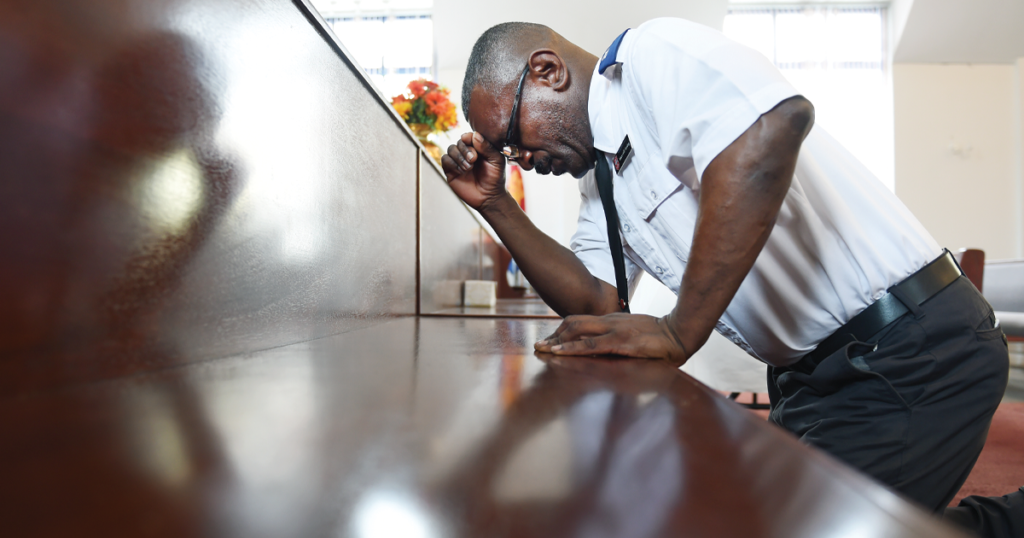The Mercy Seat: A Place to Meet With God
"The mercy seat has become a place where addicts have stood up sober, the defeated have found victory, the troubled have found peace, and the sinner has found salvation."
“Salvation” is not only at the center of its name; it is also the essential mission of The Salvation Army. When recounting a conversation he’d had with William Booth, the distinguished American composer John Philip Sousa said, “He told me ‘When the Army picked up a man they offered him soup, then soap and finally salvation.’” While the dispensing of soup or soap requires straightforward logistics, Booth decided that the Army’s major delivery system of salvation would be through the mercy seat—a wooden bench at the front of a worship hall.
The idea was that after delivering a gospel sermon, the preacher would invite a here-and-now response, calling the congregation to step forward to the mercy seat as a sign of commitment to Christ and of the need for spiritual counsel. It is a method that is still widely used throughout the Salvation Army world today. But how did the Army get its mercy seat, also known in some countries as “the altar”?
The line can be directly traced to a visit to England in 1846 by Irish-American preacher James Caughey. Witness to one of Caughey’s revivalist meetings in Nottingham while he was a teenager, Booth later recounts, “I saw as clearly, as if a revelation had been made to me from Heaven, that success in spiritual work, as in natural operations, was to be accounted for … on the employment of such methods as were dictated by common sense, the Holy Spirit, and the word of God” (“Twenty-One Years Salvation War”).
Not long after, using such methods, Booth brought “Besom Jack”—a notorious drunkard and wife-beater—to the point of decision at a wooden bench (“God’s Soldier: General William Booth”).
Caughey himself was converted during the Second Great Awakening, a revival movement that swept through the States in the early 19th century. One of its major features was the camp meeting, where families gathered in the country to hear old-time religion preaching.
In “The Effective Invitation,” R. Alan Streett calculates that the first recorded use of an altar in connection with a public invitation occurred in 1799. At a Methodist camp meeting at Red River, KY, an altar was erected in front of the pulpit designed as a place for penitents, where they might be collected together for prayer and instruction.
Around this time, the altar was gaining a new name—“the mourners’ bench.” The idea being that this was the place to mourn one’s sin and sinful behavior.
“The Dictionary of Christianity of America” records that “the Cane Ridge, KY, meeting in the summer of 1801 was attended by thousands and set the stage for the camp-meeting approach with its emotional appeals, use of the mourners’ bench and the holding of periodic meetings at which the Spirit moved.”
The altar call approach, favored in more recent times by evangelists such as Dr. Billy Graham, had many early-day exponents across numerous denominations. Perhaps the most famous is Presbyterian minister Charles Grandison Finney, whose revival meetings attracted thousands on both sides of the Atlantic.
In “Lectures on Revivals of Religion” (1835), Finney defines what he calls “the anxious seat” as “some particular seat in the place of meeting, where the anxious may come and be addressed particularly, and be made subjects of prayer, and sometime conversed with individually.”
Perhaps The Salvation Army’s greatest mercy-seat exponent and front-line fighter was Indiana-born holiness teacher Samuel Logan Brengle. In 1919, he recorded that in the first six months of that year he had witnessed “considerably over 3,000 souls … at the penitent form in my meetings, seeking pardon and purity.”
Although in his many books Brengle exclusively uses the term “penitent form,” it and “mercy seat” have long been used to describe the same place and concept interchangeably.
Brengle widened the purpose of the prayer bench. Originally a place to seek salvation, he designated it as the place to seek sanctification or the second blessing of holiness. While some corps introduced a holiness table as the locus of a sanctification response, Brengle always called people, whatever their spiritual need, to the mercy seat.
The term “mercy seat” first appeared in The War Cry in January 1882: “Several poor drunkards rose to their feet and walked boldly to the penitent form, where … they laid hold of Christ by faith … In the Theatre we had a glorious time, 14 souls found their way to the mercy seat.”
Although kneeling at the mercy seat is an outward sign of an inner spiritual impulse, the act is not a sacrament. The mercy seat is a place of grace but it is not the means of grace in the way that sacraments are perceived to be. Receiving salvation or holiness does not depend on spending time at the mercy seat. Salvationists believe in an any-time-any-place-anywhere-anyone God. Therefore, response to Him—communion with Him—does not depend on time or place. Salvation Army history is filled with instances of people finding God in the street, in hospitals, at home or in a bar.
The mercy seat is not a Salvation Army invention. It originates in the Bible. Just as the stars and stripes not only identify the U.S. but also symbolize her aspirations and values, so the biblical mercy seat represents deeper truths and principles.
The original mercy seat was the golden cover of the Ark of the Covenant. It was here that God promised Moses that He would appear and advise (Exodus 25:22). It was also the place where God would forgive sin. Leviticus 16 describes how on the Day of Atonement, the high priest made the annual sin offering for the Children of Israel. Among other ceremonies, using the substitution principle established with Abraham (Genesis 22), the priest killed a goat and sprinkled its blood on the mercy seat as a sign that atonement had been made.
The Old Testament mercy seat, therefore, symbolized a God who was prepared to meet with, guide and forgive His people.
In the New Testament, these truths are found not in a golden lid but in a person—Jesus. Jesus appeared to humankind as God in the flesh (see John 1:14). Jesus sent His Spirit to “guide you into all truth” (John 16:13). As the “Lamb of God who takes away the sin of the world” (John 1:29), Jesus is the means by which, through repentance and faith, humankind can experience atonement.
This is what makes an Army mercy seat sacred. It has no inherent powers. It is not obligatory to kneel there. It is not a spiritual rite of passage. But the simple wooden bench symbolizes God’s gracious provision of His presence, empowerment and pardon. By virtue of being the location where sacred business is conducted, it is a special place. Because it is exclusively set aside as a meeting place with God, it is a holy place.
Since its adoption into the Army, the mercy seat has become a place where addicts have stood up sober, the defeated have found victory, the troubled have found peace, and the sinner has found salvation.
For further study
“The Mercy Seat Revisited” by Major Nigel Bovey (Shield Books, London, 2010): Since the genesis of The Salvation Army, the mercy seat has been central—architecturally and theologically—to its soul-saving mission. History testifies that at the mercy seat God changes lives. Nigel Bovey investigates the past to see how, where and why the mercy seat became the focal point of Salvationist worship and witness. With the help of personal insights from hundreds of other Salvationists, the author looks at how the mercy seat is currently used around the world and considers future challenges facing the mercy seat. He also examines the biblical foundations and scriptural principles for making a public response to God.







